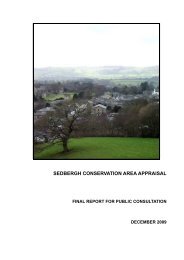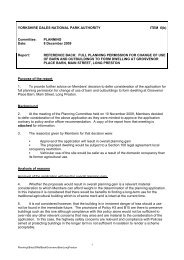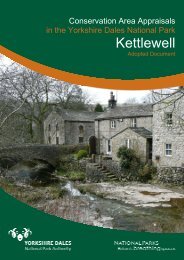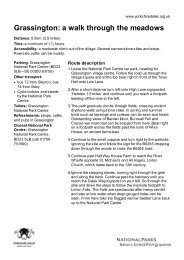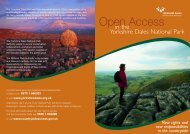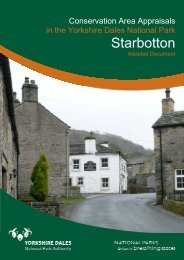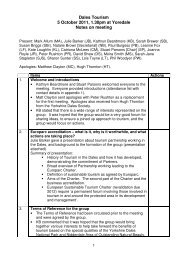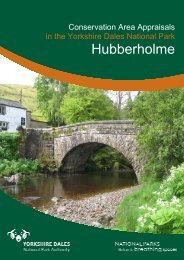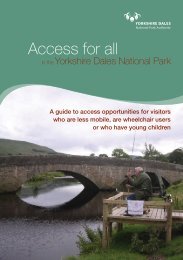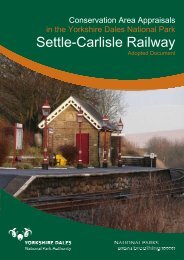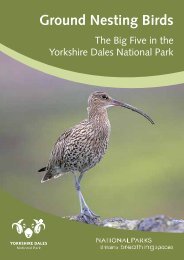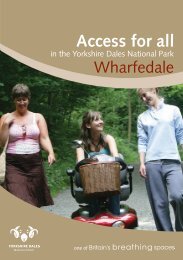Langcliffe - Yorkshire Dales National Park
Langcliffe - Yorkshire Dales National Park
Langcliffe - Yorkshire Dales National Park
- No tags were found...
You also want an ePaper? Increase the reach of your titles
YUMPU automatically turns print PDFs into web optimized ePapers that Google loves.
4Slater, Nancy (2000) ‘ABackground to the SocialHistory of <strong>Langcliffe</strong>’,http://www.langcliffe.net/Background%20Social%20History.html.b) Activity and Prevailing or Former Uses and Their Influence onPlan Form and BuildingsToday <strong>Langcliffe</strong> is a quiet residential settlement. Yet within livingmemory various shops existed in the village, such as a greengrocer’s,butcher, Co-operative store, general store, off-licence, cobbler, fish-andchipsshop and post office. There was also a Liberal Club 4 .The following paragraphs examine each character zone (see 4.4.a)regarding current and past uses, and how they influenced the layout ofthe <strong>Langcliffe</strong> Conservation Area.(1) Today the built-up core is mainly in residential use, with the exceptionof the <strong>Langcliffe</strong> Institute, which has always been a communal building,offering social or educational activities opposite the Green. Formercommercial uses in the village have only been recently abandoned.Although the buildings of this zone are predominantly in private use, mostof the external space is accessible to the public.The built-up core mainly comprises terraced stone cottages (figure 23)which used to house the mill workers and their families. In addition, thereare some old farm buildings that are now turned into residentialaccommodation. In the past, there was more of a working environment inthis zone, resulting from the agricultural function to some extent butmainly the industrial community that lived here.The built environment is fairly densely knitted in this zone, with someexceptions towards its edges. In general, the buildings are arranged sothat they radiate from the central square with the fountain and StocksTree. Also, those closest to the B6479 either lead towards or face theroad and the mill beyond. In the northeast of this zone, this layout isbroken. Here, the buildings are more orientated towards the Green.(2) Except for some private gardens, the Green is a predominately publicspace. This is reflected in the original functions of several buildings in thezone, which were used for religious, educational or employmentpurposes. Today, only the church has retained its use, while others wereturned into residential accommodation, except for the school which iscurrently empty.It is notable that the buildings stand quite separate from each other andare orientated towards the centre of the Green. Those designed for publicuse have a more individual architectural language when compared to thehumble cottages of the previous zone. Also, they all possess landmarkqualities, which is enhanced by the picturesque setting (figures 17-19).(3) <strong>Langcliffe</strong> Hall is the largest property in the village when comparedwith the other houses, including the simple workers’ cottages. Despite itsseclusion from the main settlement, it is actually very close to theadjacent properties and aligned with them. The entire character zone is aprivate residence.(4) Built as a private residence, Bowerley was heavily modified andextended in the late twentieth century. The property now consists of acluster of various buildings set amidst the large grounds and has alandmark position when viewed from the main road, to which it is aligned.Today the place also caters for holiday lettings.c) Quality of Buildings and Their Contribution to the AreaOverview. The present village mainly originates from the seventeenth tonineteenth centuries, when much of its employment depended on theearly-industrial mills, quarries and lime kilns nearby (see 4.2.a). At theend of the eighteenth and beginning of the nineteenth centuries, therewas the first wave of building, with terraced stone cottages providing26



